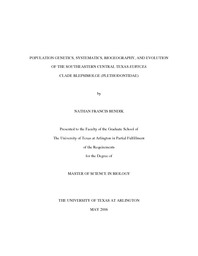
ATTENTION: The works hosted here are being migrated to a new repository that will consolidate resources, improve discoverability, and better show UTA's research impact on the global community. We will update authors as the migration progresses. Please see MavMatrix for more information.
Show simple item record
| dc.contributor.author | Bendik, Nathan Francis | en_US |
| dc.date.accessioned | 2007-08-23T01:56:30Z | |
| dc.date.available | 2007-08-23T01:56:30Z | |
| dc.date.issued | 2007-08-23T01:56:30Z | |
| dc.date.submitted | May 2006 | en_US |
| dc.identifier.other | DISS-1238 | en_US |
| dc.identifier.uri | http://hdl.handle.net/10106/332 | |
| dc.description.abstract | The central Texas Eurycea are a diverse group of perennibranchiate salamanders which inhabit the Edwards Plateau. Although several studies have addressed the systematics and taxonomy of this group, little is known about species boundaries within the southeastern Blepsimolge. Here I assess genetic variation and phylogenetic relationships both within and among species of the southeastern Blepsimolge. Using mitochondrial DNA sequences of the control region, I examined the population structure and genetic variation of Eurycea nana as well as the evolution of the control region within Eurycea and other salamanders. No population structure was found among the three E. nana localities sampled and haplotype diversity in E. nana was lower than in E. sp. Comal Springs, which is consistent with previous results.
To examine species boundaries and evolutionary patterns among the southeastern Blepsimolge, I used three mitochondrial DNA products (control region, cytochrome b, and partial ND2), totaling 3,252 base pairs, to reconstruct phylogenetic relationships. Several species boundaries recovered in this study do not appear to be wholly consistent with previous designations. Eurycea latitans is paraphyletic and appears to be conspecific with E. tridentifera. Populations of E. pterophila form a weakly-supported monophyletic group and the range of this species extends beyond springs and caves in the Blanco River basin, contrary to previous inferences. Deep divergences within the southeastern Blepsimolge among taxa distributed along the Edwards fault zone aquifer suggest that formation of the Edwards Aquifer and compartmentalization within it may have been integral to the early diversification of this group. Subsequent dispersal and diversification probably ensued when the Lower Glen Rose limestone in the central portion of their distribution was exposed. Aquifer and cavern development in the region provided access to novel habitat that was exploited by salamanders. Finally, phylogenetic analyses revealed recurring patterns of morphological convergence among hypogean populations with cave-associated morphologies. | en_US |
| dc.description.sponsorship | Chippindale, Paul | en_US |
| dc.language.iso | EN | en_US |
| dc.publisher | Biology | en_US |
| dc.title | Population Genetics, Systematics, Biogeography, And Evolution Of The Southeastern Central Texas Eurycea Clade blepsimolge (Plethodontidae) | en_US |
| dc.type | M.S. | en_US |
| dc.contributor.committeeChair | Chippindale, Paul | en_US |
| dc.degree.department | Biology | en_US |
| dc.degree.discipline | Biology | en_US |
| dc.degree.grantor | University of Texas at Arlington | en_US |
| dc.degree.level | masters | en_US |
| dc.degree.name | M.S. | en_US |
| dc.identifier.externalLink | https://www.uta.edu/ra/real/editprofile.php?onlyview=1&pid=12 | |
| dc.identifier.externalLinkDescription | Link to Research Profiles | |
Files in this item
- Name:
- umi-uta-1238.pdf
- Size:
- 3.877Mb
- Format:
- PDF
- Name:
- CombinedAlignment_Chapter3.nex
- Size:
- 277.0Kb
- Format:
- Unknown
- Name:
- combined_alignment_Chapter2.nex
- Size:
- 84.41Kb
- Format:
- Unknown
This item appears in the following Collection(s)
Show simple item record


